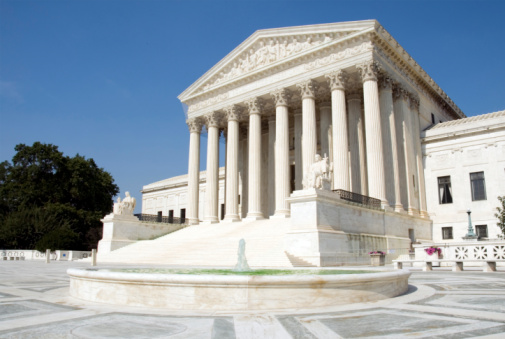
The Regulatory Review highlights the regulatory decisions from the Supreme Court’s past term.
In the wake of Justice Antonin Scalia’s untimely death this past February, a cloud of uncertainty was cast over the Supreme Court. Missing one of its conservative standard-bearers, sitting in equipoise, and faced with the prospect of a sea change in the Court’s composition, the suddenly eight-member-strong bench appeared to have an unclear path forward.
In the face of such uncertainty, the Supreme Court ended its 2015–2016 term this past month having made at least one point abundantly clear: The decisions that it handed down in a whole host of cases will have far-ranging effects on the regulatory landscape. These cases included issues concerning women’s health, the nation’s electricity markets, immigration policy, and redistricting, among numerous other issues with important regulatory and administrative law implications.
One of the decisions that garnered countless headlines was Whole Woman’s Health v. Hellerstedt, which more definitively established how far states can go when regulating abortion. In another high-profile case, Fisher v. University of Texas, the Court upheld the University of Texas’s affirmative action admissions program—thus signaling that universities can take race into account in their admissions processes.
But other lesser-known decisions will also likely have a major impact on regulation. In the United States Army Corps of Engineers v. Hawkes Co., for example, the Court held that a jurisdictional determination constituted a final agency action subject to judicial review—a decision that will have the effect of reducing the legal uncertainty associated with jurisdictional determinations.
In this series, The Regulatory Review presents essays highlighting key Supreme Court decisions. Prominent legal experts and The Regulatory Review staff will provide their insights about the significance of the past term’s decisions. The series kicks off with an essay by Professor Allison K. Hoffman on Burwell v. Zubik, which resolved the latest legal battle over the Affordable Care Act’s contraceptive coverage requirement.
Still Seeking Contraceptive Compromise After Zubik v. Burwell
July 11, 2016 | Allison K. Hoffman
Zubik v. Burwell marked the Affordable Care Act’s (ACA) latest appearance on the Supreme Court stage. Consolidated with six other cases, Zubik involved a challenged to the ACA’s requirement that group health plans and health insurance issuers provide free coverage of preventative health care services, including all contraceptive methods that are approved by the U.S. Food and Drug Administration.
Finality and the Virtues of Jurisdictional Declarations
July 12, 2016 | Emily S. Bremer
In United States Army Corps of Engineers v. Hawkes Co., the Supreme Court held that a “jurisdictional determination” issued by the U.S. Army Corps of Engineers constituted a final agency action subject to judicial review. The fact that the Supreme Court’s decision was unanimous, yet also yielded four separate opinions, hints at the nuanced and important administrative law issues that lurk in the details.
Supreme Court Hands Down Sentence on Errors in Sentencing
July 13, 2016 | Alina Artunian
Sentencing guidelines are aimed at solving problems implicated by both unduly lenient as well as overly harsh sentences. The federal courts must consult sentencing guidelines when deciding how long convicted felons will spend time in federal prison. In its last term, the Supreme Court took up the case of Molina-Martinez v. United States, which involved a claim that a federal court had misapplied the guidelines.
Supreme Court Strikes Down Texas Abortion Law
July 14, 2016 | Jennifer Ko
State abortion laws around the United States may be due for an overhaul. Late last month, in Whole Woman’s Health v. Hellerstedt, the U.S. Supreme Court considered and struck down a Texas law that restricted women’s access to in-state abortion services, finding that the law violated the constitutional right that women have to obtain an abortion.
A Shift in the Energy Regulatory Regime
July 18, 2016 | David Spence
The Supreme Court’s decisions in this term’s energy cases—Federal Energy Regulatory Comm’n v. Electric Power Supply Ass’n and Hughes v. Talen Energy Marketing—raise important issues. For one, both decisions underscore states’ reduced leverage in light of the transition from traditional regulation to competitive power markets. Second, Hughes raises questions about how states can continue to subsidize preferred merchant—that is, non-utility—generators.
Redistricting Law Refined
July 19, 2016 | Daniel Tokaji
The Supreme Court case, Harris v. Arizona Independent Redistricting Commission, lies at the intersection of two important developments in the law of redistricting: the use of independent commissions to draw district lines, and the refinement of the one person, one vote rule. A brief look at the history of redistricting is vital to understanding Harris’s significance as well as the bigger issues the decision implicates.
Executive Power After United States v. Texas
July 20, 2016 | Patricia Bellia
The Court’s non-resolution of certain difficult questions in United States v. Texas provides an occasion to reflect on the substantive and institutional dimensions of executive power to reshape statutory policy through non-enforcement decisions. What limits, if any, exist on that power? Who determines what those limits are? Although courts can provide some limits on executive power, those limits depend first and foremost on congressional legislation.



